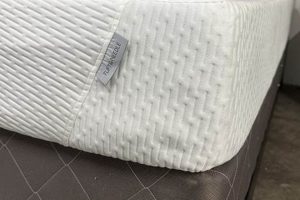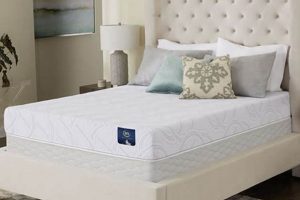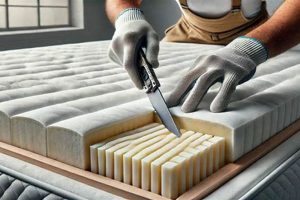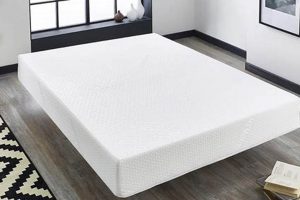The duration for which a memory foam sleeping surface remains supportive and comfortable varies. Factors influencing this period include foam density, manufacturing quality, usage patterns, and environmental conditions. For instance, a high-density product used by a single individual in a climate-controlled environment will typically exhibit a longer serviceable time than a low-density option subjected to heavier use and fluctuating temperatures.
Understanding the expected usability period offers significant advantages. It allows consumers to plan for future replacements, ensuring continuous sleep quality. Furthermore, it aids in making informed purchasing decisions, balancing upfront costs with long-term value. Historically, bedding material longevity was a secondary consideration; however, increasing awareness of sleep health and product sustainability has elevated its importance.
The following sections will delve into the specific elements impacting this duration, methods for extending it, and indicators that signal the need for a replacement. Subsequent discussions will also address comparisons with other mattress types and provide guidance on proper care and maintenance.
Extending the Usability Period of Memory Foam Mattresses
Maximizing the functional duration of a memory foam mattress requires adherence to specific preventative measures and appropriate maintenance practices. The following guidelines are designed to preserve its integrity and performance characteristics.
Tip 1: Employ a Protective Mattress Encasement: Utilizing a high-quality, waterproof mattress protector shields the foam from moisture, spills, and dust mites. This barrier prevents internal degradation and mitigates allergen accumulation.
Tip 2: Rotate Regularly: Rotating the mattress every three to six months distributes wear evenly. This practice minimizes the formation of body impressions and prevents localized sagging.
Tip 3: Ensure Adequate Support: A robust bed frame with proper center support is crucial. Inadequate support can lead to premature deformation and structural failure of the mattress.
Tip 4: Control Environmental Humidity: High humidity levels can promote mold and mildew growth within the foam. Employing dehumidifiers or ensuring adequate ventilation helps maintain a dry environment.
Tip 5: Practice Proper Cleaning Techniques: When cleaning spills, avoid harsh chemicals and excessive moisture. Spot cleaning with a mild detergent and thorough drying is recommended.
Tip 6: Minimize Direct Sunlight Exposure: Prolonged exposure to direct sunlight can degrade the foam’s cellular structure. Shading windows or using room-darkening curtains reduces UV damage.
Tip 7: Vacuum Periodically: Regularly vacuuming the mattress surface removes dust, debris, and allergens. This practice contributes to improved hygiene and extends material integrity.
Adopting these measures significantly enhances the product’s longevity and preserves its intended comfort and support qualities. Consistent application of these strategies represents a sound investment in maintaining sleep health.
The subsequent section will address indicators that suggest the product has reached the end of its usable life, necessitating replacement for optimal sleep quality.
1. Foam Density
Foam density is a primary determinant of the longevity of a memory foam mattress. It refers to the mass of foam per unit volume, typically measured in pounds per cubic foot (lbs/ft). Higher density foams generally exhibit superior durability and resistance to deformation, directly impacting the mattress’s serviceable duration.
- Resistance to Sagging and Impressions
Higher density foams possess a greater capacity to withstand prolonged pressure without permanently compressing. This resistance to sagging and body impressions is crucial for maintaining consistent support and preventing discomfort over time. For example, a 5 lb/ft foam will generally resist body impressions better than a 3 lb/ft foam, resulting in a longer usable lifespan.
- Durability and Structural Integrity
Denser foams exhibit enhanced structural integrity, making them less susceptible to tearing, crumbling, or losing their shape. This contributes to the mattress’s ability to endure regular use and maintain its original form. Low-density foams are more prone to breakdown, particularly under concentrated pressure points, thereby shortening the period they provide adequate support.
- Support and Responsiveness
While not solely determined by density, higher density foams often provide superior support and responsiveness. The foam’s ability to quickly recover its shape after compression is essential for conforming to the body’s contours and alleviating pressure points. A dense foam typically offers a more consistent and reliable sleep surface compared to a less dense alternative.
- Impact on Cost and Value
Mattresses with higher density foams typically command a higher initial price due to the increased material costs. However, their extended usability period can translate to better long-term value. The need for frequent replacements is reduced, offsetting the higher upfront investment. A lower density mattress might be more affordable initially but could require replacement sooner, incurring additional expenses over time.
The interconnectedness of foam density, support, durability, and resistance to sagging emphasizes its profound impact on the overall product longevity. Selecting a memory foam mattress with an appropriate density based on individual needs and usage patterns is a critical factor in maximizing its use and ensuring sustained sleep quality.
2. Usage Frequency
The frequency of use directly impacts the longevity of a memory foam mattress. Increased usage translates to more frequent compression and decompression of the foam cells, accelerating material fatigue. A mattress used nightly by one individual will typically exhibit a longer functional duration compared to an identical mattress used by two individuals or in a guest room occupied sporadically.
Higher occupancy rates lead to increased stress on the support structure and the foam itself. This accelerated wear can manifest as sagging, indentations, and a loss of overall support. For example, a mattress in a master bedroom subjected to consistent nightly use may exhibit signs of wear, such as body impressions, within five years. Conversely, a similar mattress in a sparsely used guest bedroom could maintain its integrity for a longer period, possibly extending beyond seven years. The correlation between usage and degradation highlights the importance of considering the anticipated load and occupancy when sele
cting a mattress.
Ultimately, the relationship between usage and degradation underscores the significance of selecting appropriate materials and construction techniques to mitigate the impact of frequent use. Understanding the anticipated frequency of occupancy is vital for informed mattress selection and maximizing its usable duration. This awareness contributes to responsible consumption and can influence maintenance strategies to extend the serviceable period of the sleeping surface.
3. Support System
The underlying support system of a memory foam mattress significantly influences its longevity and overall performance. This system, typically composed of innersprings, coils, or a dense foam base, provides the structural foundation necessary for distributing weight and preventing premature sagging. A weak or inadequate support system causes the memory foam layers to compress unevenly and lose their ability to conform to the body’s contours, ultimately shortening the mattress’s usable lifespan. For example, a memory foam mattress placed on a bed frame with widely spaced slats lacks adequate support, leading to localized compression and accelerated deterioration of the foam layers. This can result in uncomfortable dips and reduced support within a few years, necessitating earlier replacement.
The type and quality of the support system directly correlate with the mattress’s ability to maintain its shape and provide consistent comfort over time. Innerspring systems, characterized by interconnected coils, offer varying levels of support depending on their gauge and design. Pocketed coil systems, where each coil is individually encased, reduce motion transfer and provide more targeted support. Dense foam cores, often found in all-foam mattresses, provide a stable and uniform base. An appropriate support system ensures even weight distribution, preventing concentrated stress points that can compromise the memory foam’s structure. Choosing a mattress with a robust support system, specifically designed to complement the density and thickness of the memory foam layers, is crucial for maximizing its functional life.
In conclusion, the support system serves as the bedrock for the memory foam layers, dictating its resistance to compression and overall durability. A deficient or mismatched support structure compromises the mattress’s integrity, leading to premature sagging, diminished comfort, and a reduced lifespan. Therefore, careful consideration of the support system’s design and construction is paramount when selecting a memory foam mattress, ensuring a longer-lasting and more supportive sleep experience. The interplay between foam density and the quality of the support system ultimately determines the product’s long-term value and performance.
4. Environmental Conditions
The surrounding environment significantly influences the longevity of a memory foam mattress. Fluctuations in temperature and humidity levels can accelerate degradation, compromising structural integrity and shortening its useful life. Exposure to excessive heat causes the foam to soften and lose its supportive properties, while high humidity promotes the growth of mold and mildew within the mattress core. These organisms weaken the foam’s cellular structure, leading to premature breakdown and the release of unpleasant odors. For example, a mattress stored in a poorly ventilated attic during summer months will likely degrade more rapidly than one maintained in a climate-controlled bedroom. Similarly, placing a mattress in a humid basement without proper protection will expose it to moisture, fostering microbial growth and diminishing its lifespan.
Direct sunlight exposure is another environmental factor that impacts the product’s lifespan. Ultraviolet (UV) radiation breaks down the chemical bonds within the memory foam, causing it to become brittle and discolored. Over time, this degradation reduces the foam’s ability to conform to the body and alleviate pressure points. Consequently, it is recommended to shield memory foam mattresses from direct sunlight by using window coverings or positioning the mattress away from direct light sources. The chemical composition of the foam also plays a role in its susceptibility to environmental factors. Some memory foam formulations are more resistant to UV degradation and moisture absorption than others. Therefore, selecting a mattress with a chemically stable composition and implementing preventive measures to control environmental conditions are crucial for preserving its structural integrity.
In summary, environmental conditions exert a profound influence on the longevity of memory foam mattresses. Elevated temperature, humidity, and direct sunlight exposure accelerate degradation, compromising the foam’s structural integrity and diminishing its supportive properties. Implementing preventive measures, such as maintaining a controlled climate, shielding the mattress from sunlight, and selecting chemically stable foam formulations, is essential for maximizing its usable life and ensuring consistent sleep quality. A holistic approach that considers both material quality and environmental management is critical for optimizing the investment in a memory foam mattress.
5. Maintenance Practices
Adherence to recommended maintenance protocols significantly impacts the serviceable duration of a memory foam mattress. Consistent and appropriate care mitigates degradation and preserves the mattress’s structural integrity, directly influencing its ability to provide support and comfort over an extended period.
- Protective Encasements
The utilization of a high-quality, waterproof mattress protector constitutes a fundamental maintenance practice. This barrier safeguards the foam from spills, moisture, and allergens, preventing internal damage and prolonging the material’s lifespan. For instance, a spill absorbed into unprotected foam promotes microbial growth and compromises its structure, whereas a protected mattress remains shielded from such incidents.
- Regular Rotation
Rotating the mattress periodically, typically every three to six months, distributes wear evenly across its surface. This practice minimizes the development of body impressions and prevents localized sagging, thereby maintaining consistent support and extending the product’s usable life. Failing to rotate the mattress results in concentrated wear, leading to premature degradation in high-pressure areas.
- Proper Support System
Ensuring adequate support from the bed frame is a crucial maintenance consideration. A robust frame with center support prevents uneven weight distribution and prevents structural damage. A bed frame with inadequate or missing support can cause the mattress to deform prematurely, diminishing its comfort and shortening its life. For example, placing a mattress on a frame with widely spaced slats negates the benefits of rotation and proper support, resulting in earlier replacement.
- Appropriate Cleaning Techniques
Employing appropriate cleaning techniques is essential for maintaining hygiene and preventing damage to the foam. Spot cleaning with a mild detergent and
thorough drying are recommended for addressing spills or stains. Harsh chemicals and excessive moisture should be avoided, as they can degrade the foam’s cellular structure. Improper cleaning practices can contribute to the rapid deterioration of the foam and a shorter lifespan.
These maintenance practices, when consistently applied, collectively contribute to extending the functional duration of a memory foam mattress. Neglecting these protocols accelerates wear and tear, leading to diminished comfort, reduced support, and ultimately, a shorter lifespan. The diligent application of preventative maintenance represents a sound investment in preserving the product’s integrity and maximizing its value over time.
6. Manufacturing Quality
The integrity of a memory foam mattress, and consequently its serviceable duration, is inextricably linked to manufacturing quality. Deficiencies in the production process, ranging from material selection to construction techniques, exert a cascading effect that ultimately compromises the product’s resilience and shortens its lifespan. Substandard materials, such as low-density foam or inferior adhesives, often lead to premature sagging, crumbling, and delamination. Inconsistent cell structure within the foam diminishes its ability to conform to the body, accelerating wear and tear. Precision in cutting and assembly is also vital; misaligned layers or poorly sealed seams create points of weakness that are susceptible to failure under pressure. The implementation of rigorous quality control measures during manufacturing serves as a safeguard, identifying and rectifying potential defects before they impact the product’s long-term performance. A mattress produced with meticulous attention to detail and adherence to stringent quality standards will inherently exhibit greater durability and a prolonged lifespan.
Beyond the physical aspects of construction, manufacturing quality also encompasses the ethical sourcing and processing of materials. Memory foam often contains volatile organic compounds (VOCs) that can off-gas over time, potentially impacting indoor air quality and human health. Reputable manufacturers prioritize the use of CertiPUR-US certified foams, which are independently tested to meet strict emissions standards. Furthermore, the responsible management of waste and energy consumption during production contributes to the overall sustainability and integrity of the product. The absence of these considerations suggests a compromise in manufacturing quality, which can correlate with a reduced lifespan and potential health risks. Real-world examples include mattresses from unknown or uncertified sources that exhibit rapid degradation and emit strong chemical odors, underscoring the tangible consequences of inadequate manufacturing practices.
In summary, manufacturing quality represents a critical determinant of a memory foam mattress’s lifespan and overall value. Investments in high-quality materials, precise construction techniques, and ethical sourcing practices translate to a more durable, comfortable, and sustainable product. Conversely, compromises in manufacturing quality result in accelerated degradation, diminished performance, and potential health concerns. Consumers who prioritize longevity and long-term value should prioritize mattresses from manufacturers with a demonstrable commitment to rigorous quality control and responsible production methods. This understanding equips consumers to make informed purchasing decisions, maximizing the return on their investment and ensuring sustained sleep quality.
Frequently Asked Questions
This section addresses common inquiries and misconceptions regarding the expected duration of usability for memory foam mattresses. The following questions and answers provide informative guidance based on industry standards and empirical observations.
Question 1: What is the typical serviceable duration for a memory foam mattress?
The expected usability period ranges from seven to ten years, contingent upon factors such as foam density, usage patterns, and maintenance practices. Higher density foams, lighter usage, and consistent maintenance contribute to a longer product life. Conversely, lower density foams, heavier usage, and neglected maintenance shorten the mattress’s functional duration.
Question 2: How does foam density affect the product’s longevity?
Foam density, measured in pounds per cubic foot (lbs/ft), directly correlates with durability. Higher density foams exhibit greater resistance to compression and deformation, resulting in a longer lifespan compared to lower density alternatives. As a general guideline, foams with a density of 5 lbs/ft or higher tend to provide superior longevity.
Question 3: What are the primary indicators that a memory foam mattress requires replacement?
Signs that a mattress has reached the end of its usable life include visible sagging or indentations, a noticeable loss of support, increased discomfort or pain during sleep, and the presence of persistent odors or allergens that cannot be eliminated through cleaning.
Question 4: Can a mattress protector significantly extend its lifespan?
Yes, a high-quality, waterproof mattress protector serves as a barrier against spills, moisture, dust mites, and allergens, preventing internal degradation and promoting hygiene. Consistent use of a protector contributes significantly to extending the mattress’s serviceable period.
Question 5: Does mattress rotation influence its longevity?
Regular rotation, performed every three to six months, distributes wear evenly across the surface, minimizing the development of body impressions and preventing localized sagging. This practice contributes to maintaining consistent support and extending the mattress’s lifespan.
Question 6: Are all memory foam mattresses created equal in terms of durability?
No, variations in material quality, manufacturing processes, and construction techniques result in significant differences in durability. Mattresses from reputable manufacturers, employing high-quality materials and adhering to rigorous quality control standards, typically exhibit superior longevity compared to those from less established sources.
In summary, several interrelated elements impact the length of time a memory foam mattress remains serviceable. Understanding these influences allows for informed purchasing decisions and appropriate care to maximize the mattress’s lifespan.
The following section provides guidance on selecting a new memory foam mattress when the current one reaches the end of its useful life.
Memory Foam Mattress Lifespan
This exploration has detailed critical elements impacting the duration of serviceable function for memory foam mattresses. Foam density, usage frequency, support systems, environmental conditions, maintenance practices, and manufacturing quality are key determinants. Strategic attention to these factors informs purchase decisions and impacts long-term product performance.
Prolonging the usability period requires informed consumer action. Responsible selection, diligent care, and realistic expectations regarding the material’s inherent limitations are crucial. Acknowledging the multifaceted nature of a memory foam mattress lifespan fosters value optimization and supports informed replacement planning when necessary.






![Best Memory Foam Mattress Queen Walmart [Deals!] Organic & Natural Mattress Buyer’s Guide: Non-Toxic Sleep Solutions Best Memory Foam Mattress Queen Walmart [Deals!] | Organic & Natural Mattress Buyer’s Guide: Non-Toxic Sleep Solutions](https://mattressworldpa.com/wp-content/uploads/2025/07/th-3980-300x200.jpg)
